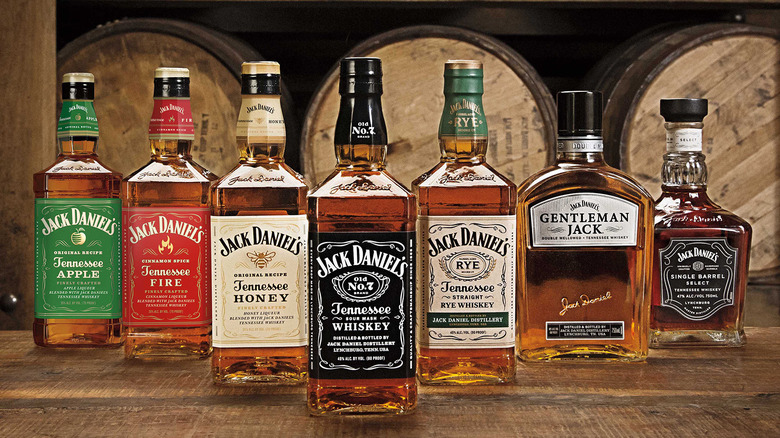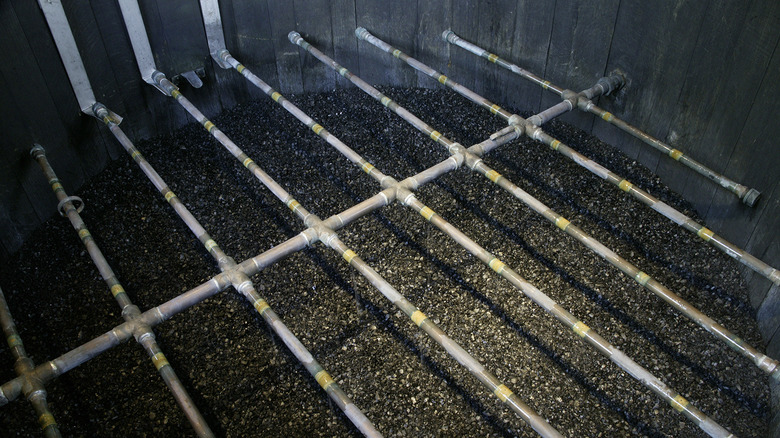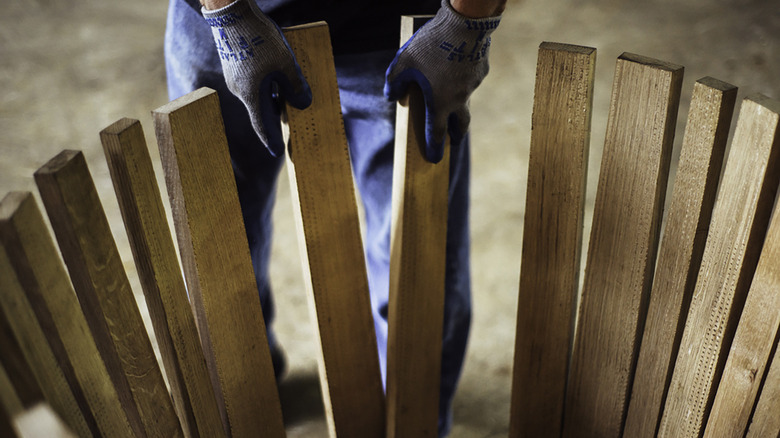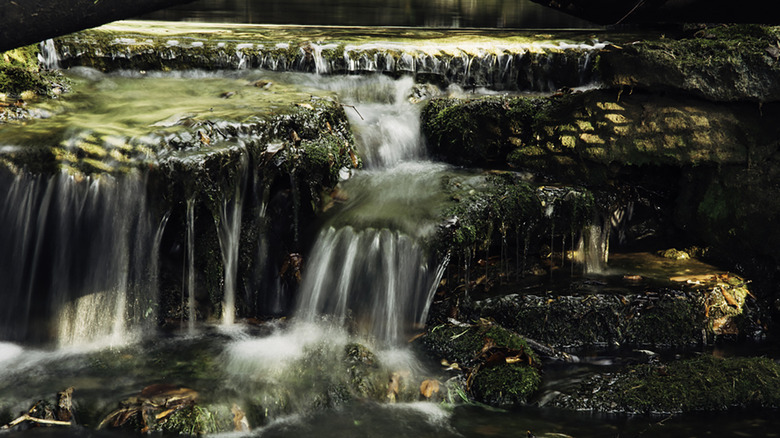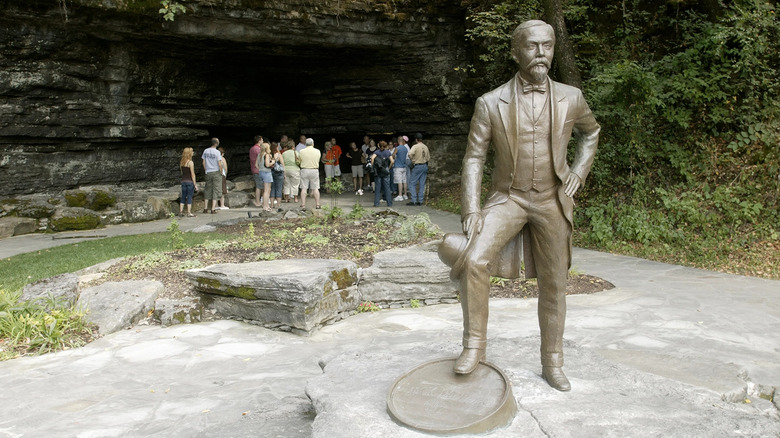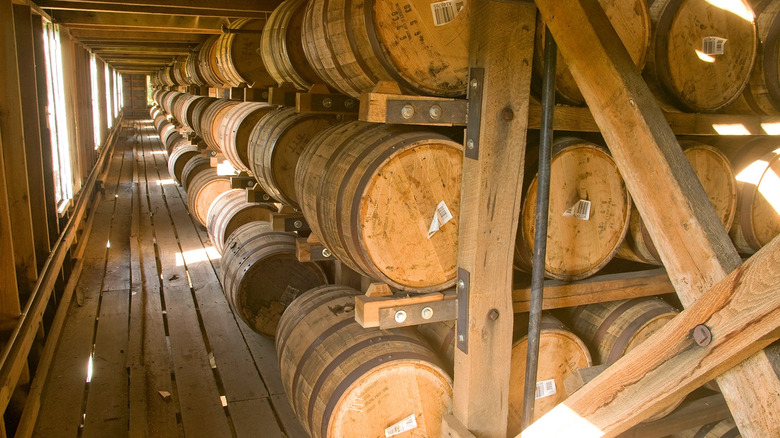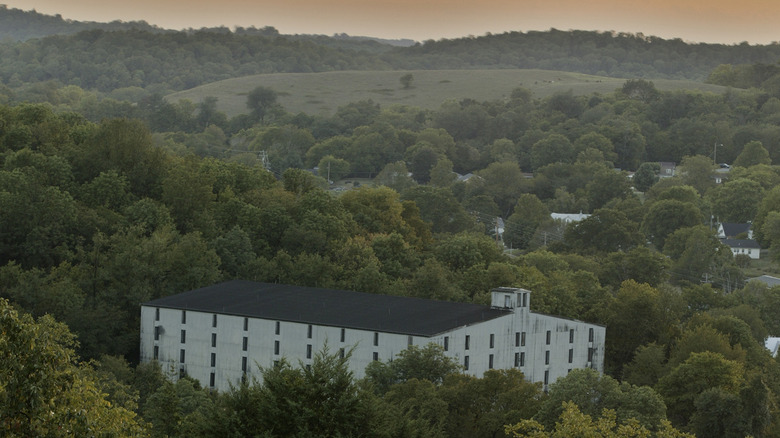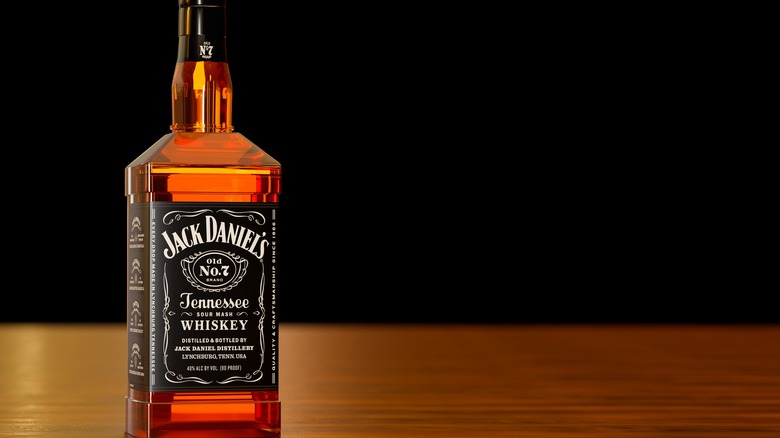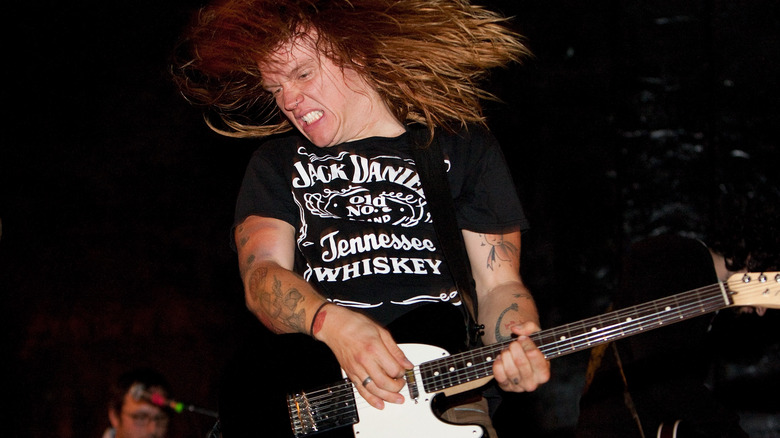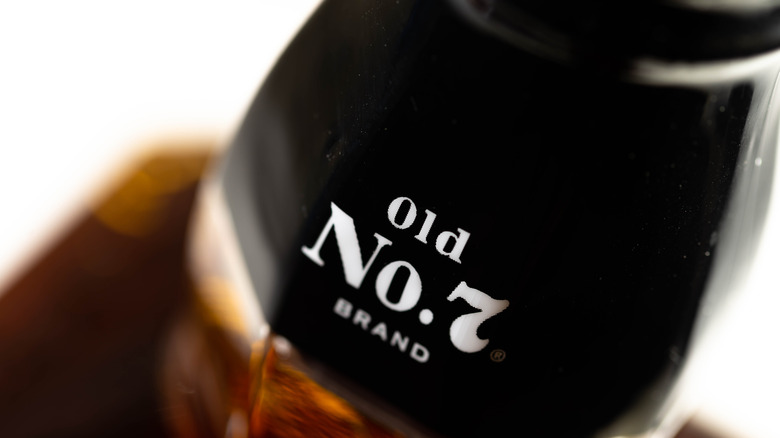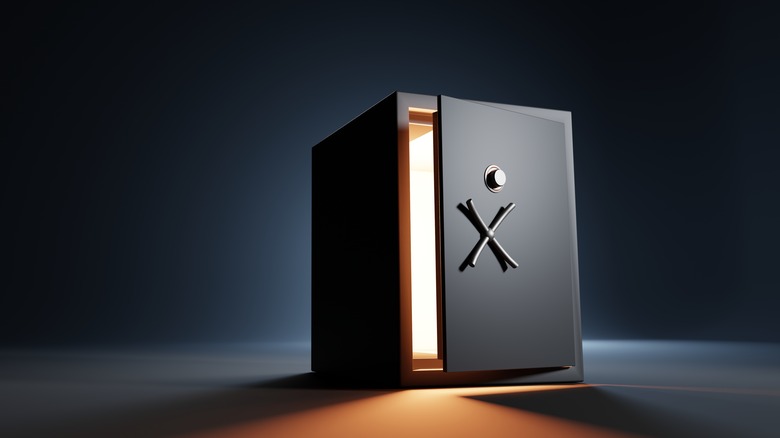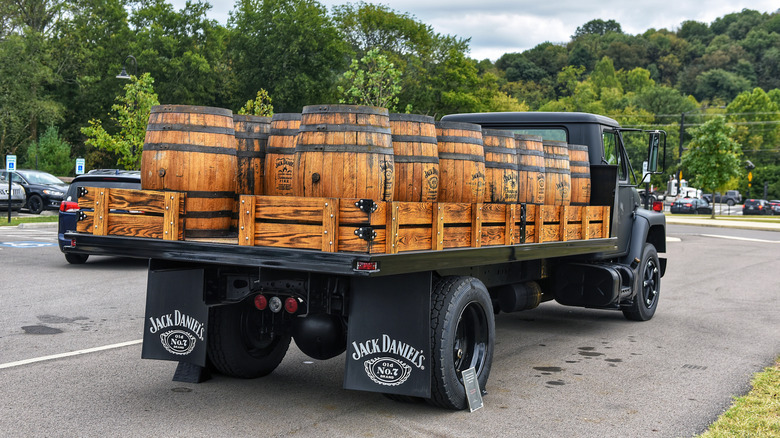Facts About Jack Daniel's Whiskey You Didn't Know
Tennessee — despite its immediate association with whiskey — has had a long and complicated history with the production of liquor. The spirit was first produced in the state in the early 1800s. (Eventual president Andrew Jackson may have even helped popularize the tipple.) Despite a lengthy stoppage in the manufacturing of alcohol in the early 1900s, whiskey is now one of Tenneessee's top exports. In fact, Tennessee implemented this ban on alcohol production 10 years before Prohibition in 1920, and then waited about three and a half years after the end of Prohibition (via the 21st Amendment), before repealing its own state-wide ban. That day was May 21, 1937. Today, the date is celebrated as International Tennessee Whiskey Day.
To dig a little deeper into the world of Tennessee whiskey and its perhaps most well-known product, Jack Daniel's, Tasting Table spoke with the distillery's chief historian, Nelson Eddy. He is a treasure trove of fun facts about the history of the brand, the state's liquor laws, and Jack himself. Here, we've compiled our favorite facts from the conversation, many of which — as regular whiskey-drinkers — we were even unaware of.
Jack Daniel's meets the criteria for a bourbon — but opts for the Tennessee whiskey label instead.
Colloquially, you may hear Jack Daniel's called a bourbon; however, Jack Daniel's is not a bourbon — but that's by choice. Jack Daniel's (along with many other Tennessee whiskeys) meets all the criteria set out by the American Bourbon Association to consider itself a bourbon. However, the company claims that one additional step separates it: the process of charcoal mellowing, also called "The Extra Blessing" by Jack Daniel's.
This step, also known as the "Lincoln County Process" (named so for the original county in which Jack Daniel's distillery was located), involves the distilled 140-proof, un-aged whiskey filtering through charcoal. Gravity does all the work. The process can take between three to five days per batch to complete.
"We like to say we do bourbon one better by putting it through the 10 feet of charcoal," says Nelson Eddy. The point? This process helps mellow the spirit by removing impurities. While Jack Daniel's was not the first to begin using this technique (Eddy says charcoal filtration dates back to ancient Egypt), Jack himself realized the importance of changing out the charcoal frequently, as once it had absorbed all it could, it would no longer filter the whiskey. "At a time when everybody was doing it the same way, Jack was all about quality," says Eddy.
The choice of wood plays an important role in the process
Every ingredient in Jack Daniel's whiskey is chosen for a specific reason — even down to the wood used. In the charcoal mellowing process, the distillery uses hard sugar maple. The distillery will burn the wood (using un-aged whiskey to ignite the fire) to create the charcoal, dousing the flame just before it becomes ash. Funny enough, based on the name, you might think hard sugar maple is used to help impart a sweeter flavor into the bourbon. It's actually used for the opposite reason. "What we found is that hard sugar maple doesn't impart a taste," Nelson Eddy says. "What it really does is it acts as a filter and takes things out of the whiskey. It's not an additive process; it's a reduction process."
That flavor, however, is mostly derived from the time it spends aging in a barrel, which is why Jack Daniel's exclusively uses northern white oak (the standard in American and Tennessee whiskeys). Since one barrel may impart a slightly sweeter or smokier flavor than the barrel next to it, around 200 barrels are batched together to ensure a consistent flavor profile. These barrels can be used only once, so after each batch they are often sold to Scotch whisky distilleries, breweries, wineries, or tobacco producers.
Even the water must come from a specific source
All water used in Jack Daniel's products before distillation comes from one specific location: Cave Springs. Located about 71 miles away from the distillery, Jack purchased this land in 1884 as the limestone caves allowed for a highly filtered water source. "The limestone filtering of spring water is one of the reasons Kentucky and Tennessee are known for whiskeys," Nelson Eddy says.
This limestone filtering does two things for the water, according the Eddy: "That limestone layer imparts the water with minerals that the yeast will thrive on, so it makes it a healthy water source for the yeast. And it's iron-free; if you have iron in the water, it is going to show up in the product and it's going to change the color."
While this remains the only water sourced used by Jack Daniel's before the proofing step, it was not always the only water used. For the first 18 years, the distillery used water from the Dan Call farm, where Jack Daniel was taken in after leaving home around the age of 15. Another source of water is also used in the proofing step, which brings the spirit from 140-proof to 80-proof. This water comes from a lake and undergoes reverse osmosis to strip it of all minerals, to not impact the flavor or color.
Jack learned the trade from an emancipated slave
It was on the Dan Call farm where Jack Daniel learned the "art" of whiskey-making. It was long reported that Jack learned the process from Dan Call himself but it was actually Nathan "Nearest" Green who taught Jack everything. Rumor has it Call was too busy to do it himself and left the task up to Nearest. Among the things Nearest taught Jack was charcoal mellowing. The crux of the story, however, is that Nearest was born into slavery and freed after the Civil War.
Initially, Jack opened a distillery with Call, but after the latter left the whiskey business, Jack invited the recently emancipated Nearest on board. He was named the first head distiller for Jack Daniel's. Those in this role today are called the Master Distiller. Even better: A member of the Green family lineage has always worked at the Jack Daniel's distillery.
Jack Daniel's doesn't measure its whiskey in years
Typically, whiskies are bottled after a predetermined barrel-aging process — be it three, five, 10, 15, or more years. Jack Daniel's doesn't rely on time in its formula for crafting its standard Old No. 7 Tennessee Whiskey. As mentioned above, since one barrel may result in a slightly different flavor than the one next to it (the reason for batching multiple barrels to create a single product), certain barrels in the warehouse will age faster than others.
Typically, barrels stored near the ceiling will age faster since the more dramatic changing of temperatures will speed up this process. But weather will also play a big role. Nelson Eddy reminds us that as an international brand, Jack Daniel's needs to remain consistent in the color and taste of it's signature product. There are standards to keep to, after all. The company uses instruments to maintain a regular bond level and appearance, for example. Still one three-year period of barrel aging might not equate to the same whiskey as another three-year period, which is why Jack Daniel's relies on its Master Tasters to determine when the product is ready.
"The very best way — the only way — to truly make sure it's consistent is to taste it," says Eddy. "Because that's how all of our consumers are going to judge it. They're not going to run it through instrumentation, they're going to drink it."
The Jack Daniel's distillery operates in a dry county
Although Tennessee repealed its state-wide ban on the manufacturing of alcohol, local jurisdictions were left to determine for themselves if they would follow suit. Moore County, home to Jack Daniel's Distillery, simply never voted to repeal the ban and remains a dry county today. "They could vote that county wet anytime they wanted to [but] they've never felt the need to do that," says Nelson Eddy. "They'll tell you the nearest liquor store is 12 miles, four steps, and one screen door away."
So, while there isn't a liquor store in the county to sell a bottle of Jack Daniel's to residents, employees are given a bottle for free the first Friday of each month (this is dubbed "Good Friday"). "Nobody is ever sick on Good Friday, but every once in a while someone doesn't show up to work on Monday," Eddy adds. If you're touring the distillery, though, you will be relieved to hear that you can taste and purchase products on site (at a bit of a markup, however).
Jack Daniel's has only stopped production twice in its history
Jack Daniel's is nearing its 150th year in business, surviving two lengthy stoppages in production. The first and lengthier stoppage took place in the early 1900s when the state (and then country) went dry. For a bit during this time, Jack's nephew Lem Motlow (now the owner of Jack Daniel's) moved operations to St. Louis and to northern Alabama. Neither operation lasted long and none of the whiskey produced at these sites were sold. Once the 18th Amendment went into effect, Jack Daniel's ceased manufacturing liquor.
It wasn't until World War II that the distillery again had to stop producing whiskey. To be specific, the distillery continued to make alcohol for military purposes, but due to rationing, Jack Daniel's would have had to use a lower-grade corn than it wanted. The brand chose instead to halt the production of Jack Daniel's signature product. This time, however, people were still able to purchase its whiskey since Jack Daniel's has plenty of product in its warehouse.
There's a simple, but specific, reason Jack Daniel's uses square bottles
One thing that immediately differentiates Jack Daniel's from many of the liquors surrounding it on the shelf is its now-iconic square bottle shape. In the distillery's early years, it would sell barrels of whiskey directly to wholesalers who would either bottle it and sell it or would sell it directly from the barrel to your jug. Jack's nephew Lem Motlow then convinced him to start bottling the whiskey himself to ensure the quality of the product. But, then, the question remained: Which bottle to use?
As Nelson Eddy tells it, a bottle salesman from Alton, IL, kept bringing samples to the distillery, and again and again Jack rejected them. On or around his third trip, the salesman again went through all of the bottles, none pleasing Jack. He did, however, leave one in the bag, reluctant to show it off since it wasn't a standard whiskey bottle. Well, as soon as the man took the square bottle out of his bag, Jack told him that one the one. "A square bottle for a square shooter like me," Jack apparently said.
"In other words," Eddy tells us, "I'm an honest guy, and what you get in that bottle is going to be the real deal." Jack Daniel's has remained in a square bottle ever since — except for 1947 when a glass shortage following World War II forced the distillery to use a more typical, circular bottle.
Old No. 7 is Jack Daniel's best-selling item, but the second-best isn't a whiskey
Jack Daniel's produces and bottles upwards of 30 whiskeys and whiskey-related products. Most of these are available globally and the few that are exclusive to the United States are special editions that have limited availability. Only one of these products — Old No. 7 — would Jack even recognize. Since his day, the distillery has broken ground into the realms of American single malt whiskey, ryes, flavored expressions (such as cinnamon, green apple and honey) and even into mixed drinks (like "ready-to-drink" Jack & Coke, Jack Apple & Frizz, Jack Honey & Lemonade").
That said, 150 years later and Old No. 7 remains the brand's most tried-and-true product. Despite all the new options available, it remains the distillery's top-selling item. But what's second on the list? Well, it's not one of the 25 to 30 whiskeys or whiskey-related products Jack Daniel's sells. Not the Jack Daniel's Sinatra Select, not the Jack Daniel's Single-Barrel Barrel-Proof or Jack Daniel's Single Barrel Rye, nor is it the Jack Daniel's 12-Year-Old Batch 2. In fact, it's a tee-shirt with the Jack Daniel's Tennessee Whiskey logo on it. Nelson Eddy says it's one of the Jack Daniel's products (along with Old No. 7) that you will see worldwide.
No one knows where Old No. 7 gets its name from
Speaking of Old No. 7 ... its name remains a mystery to this day. It was one of our most pressing questions when speaking with Nelson Eddy. If anyone were to know the true tale of the name, surely it would be the Jack Daniel's Chief Historian. "That's probably the number-one question I get," he says. "But I tell you what, your guess is good as mine because Jack never told us."
Eddy, however, did enlighten us on the myriad of theories. "Several people have thought it was because Jack was in district No. 7," he says, "and then the government switched him to district No. 4, and it was a reference to that prior district, so that people didn't forget this was Jack Daniel's from old district No. 7."
Along with this quirky congressional theory, Eddy says the number might refer to something that happened during the distilling process, wherein Jack made six batches of whiskey before settling on the seventh iteration of his process as the best. Or, it might come down to love: "Some people said he had seven girlfriends and his seventh was his favorite," Eddy adds. Other possibilities include a reference to the lucky number 7, or even the way Daniel wrote his initial "J" as a "7." But in reality, "Nobody knows, says Eddy. "And Jack's not telling."
Jack Daniel (essentially) died because he forgot his safe combination
Another popular story in Jack Daniel's lore is how he died. The short (and slightly misleading) answer is that he kicked his safe, injuring his toe, which would worsen and eventually take his life. Realistically, it wasn't that simple — but there's very likely some truth to the tale. Jack did forget the combination to his safe at work and, being the only one at the distillery, had no way to open it. In frustration, he kicked it. He broke his big toe on his left foot and the injury did worsen, becoming infected. Gangrene set in, which resulted in a series of amputations attempting to stop the spread of the infection.
In time, Jack had nearly his entire leg amputated, but it never stopped the spread. About four years after the safe incident, Jack died from blood poisoning. While it's not as straightforward as Jack Daniel kicking a safe and dropping dead, company historian Nelson Eddy says that the kicking of the safe and the infections that followed likely are related.
Less than a single percent of all byproduct goes to landfills
Jack Daniel's is a product of natural elements, says Nelson Eddy. "It's wood, it's grain, it's water, and time." As something made of the earth, Eddy says that Jack Daniel's is inherently concerned with water quality and preservation, as well as tree and lumber sustainability. Plus, what Jack Daniel's doesn't contain is equally as important as what it does. The whiskey is free of artificially made flavors and colorings, for example.
To that point, "far less than 1 percent" of everything Jack Daniel's makes ends up as landfill, says Eddy. Spent mash is sold to farmers as feed (something Jack did); other mash is converted into natural gas energy. The barrels are given a second lease on life, adding flavoring to tobacco products, Scotch whiskies, beer, and more. These barrels are even sourced more locally to cut down on the carbon footprint and oak trees are constantly replanted. To that effect, sugar maples are too. (They will grow like weeds — even in your gutter, according Eddy). Jack Daniel's has helped build a solar farm to help power its production.
"We probably don't scream it from the mountaintops enough, but our sustainability record is pretty good," Eddy says. "There's a history of using and reusing that's gotten magnified in current time." When your core product relies on the quality of nature, sustainable initiatives are more than the "right" thing to do, they make business sense, as well.
